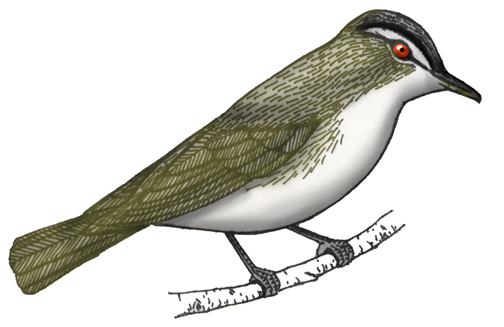

They breed in the Northwest Territory, south across Canada to Newfoundland, and south through the northern U.S. and the whole eastern U.S. through Florida. There is another group in South America.
They are located in leafy (deciduous) forests and suburban areas with big shade trees.
They have a gray head, an olive back, tail and wings and a white chest and belly. They have a white eyebrow with a black border over it and under it running through their red eyes. Males and females look alike, but males are a little bit bigger.
They are strong singers.
They eat insects and some berries.
They build an open cup nest made of twigs, grass, pine needles and spider webs and lined with grass and hair, which they hang from a tree branch. The female lays 1 - 5 white eggs speckled with reddish spots.
Kingdom: Animalia
Phylum: Chordata
Subphylum: Vertebrata
Class: Aves
Order: Passeriformes
Family: Vireonidae
Genus: Vireo
Species: V. olivaceus
When you research information you must cite the reference. Citing for websites is different from citing from books, magazines and periodicals. The style of citing shown here is from the MLA Style Citations (Modern Language Association).
When citing a WEBSITE the general format is as follows.
Author Last Name, First Name(s). "Title: Subtitle of Part of Web Page, if appropriate." Title: Subtitle: Section of Page if appropriate. Sponsoring/Publishing Agency, If Given. Additional significant descriptive information. Date of Electronic Publication or other Date, such as Last Updated. Day Month Year of access < URL >.
Amsel, Sheri. "Vireo (Red-eyed)" Exploring Nature Educational Resource ©2005-2024. December 13, 2024
< http://www.exploringnature.org/db/view/114 >

